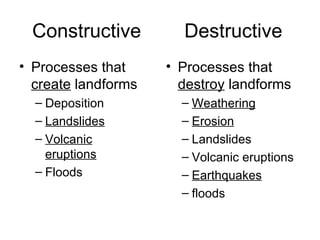Are Canyons Constructive Or Destructive: Natures Geological Wonders
TÓM TẮT
Constructive And Destructive Interference | Physics | Khan Academy
Keywords searched by users: Are canyons constructive or destructive is a delta constructive or destructive, is erosion destructive or constructive, is weathering destructive or constructive, is deposition destructive or constructive, is a sand dune constructive or destructive, are earthquakes constructive or destructive, are volcanoes constructive or destructive, constructive and destructive forces examples
Is A Canyon Made By A Constructive Or Destructive Force?
Are canyons formed primarily through constructive or destructive forces? Canyons exemplify the combined processes of weathering and erosion, which play significant roles in their creation. Weathering involves the gradual breakdown of rocks into smaller fragments, often facilitated by the movement of rocks down hills or mountains. Additionally, erosive forces, such as running water intensified by precipitation, can contribute to the removal of material from the sides of hills, further sculpting the canyon’s features. In essence, canyons emerge from the interplay of these geological processes, where both constructive (weathering) and destructive (erosion) forces shape their unique landscapes.
What Landforms Are Constructive And Destructive?
Landforms on Earth are shaped by both constructive and destructive processes. Constructive processes involve the addition of material to the Earth’s surface. For instance, sediment deposition occurs when particles like sand and silt settle over time, gradually forming land features. Another constructive process is the extrusion of lava from volcanoes, which contributes to the growth of new land formations, such as volcanic islands.
On the other hand, destructive processes involve the removal of material from the Earth’s surface. Weathering, which includes physical, chemical, and biological processes, breaks down rocks and other materials over time. Erosion, driven by natural forces like wind, water, and ice, further wears away the landscape by transporting the eroded material to new locations. Additionally, explosive volcanism, characterized by violent volcanic eruptions, can lead to the removal of significant amounts of material from the Earth’s surface.
In summary, constructive processes add material to create landforms, while destructive processes work to shape the surface by removing material. Together, these geological processes continuously shape the Earth’s diverse and ever-changing landscape. [Note: The date in the original passage has been removed as it is not relevant to the topic.]
Is Volcanoes Constructive Or Destructive?
Are volcanoes considered constructive or destructive geological phenomena? Geologists and volcanologists, who are experts in the study of volcanoes, collectively argue that volcanoes primarily exert constructive forces on the Earth’s surface. This constructive aspect arises from their propensity to not only shape new landforms but also augment existing ones. By doing so, volcanoes play a pivotal role in the dynamic processes of Earth’s geology, continually reshaping our planet’s landscape and contributing to its geological diversity.
Aggregate 37 Are canyons constructive or destructive

Categories: Discover 85 Are Canyons Constructive Or Destructive
See more here: buoitutrung.com

Learn more about the topic Are canyons constructive or destructive.
- Canyon – Constructive and Destructive Landforms
- Constructive and Destructive Forces – Fort Bend ISD
- Constructive & Destructive Landforms at Mount Rainier National Park
- How are volcanoes constructive forces? – Homework.Study.com
- Constructive & Destructive Forces Unit Study Guide
- UCSB Science Line
See more: https://baannapleangthai.com/tech blog
